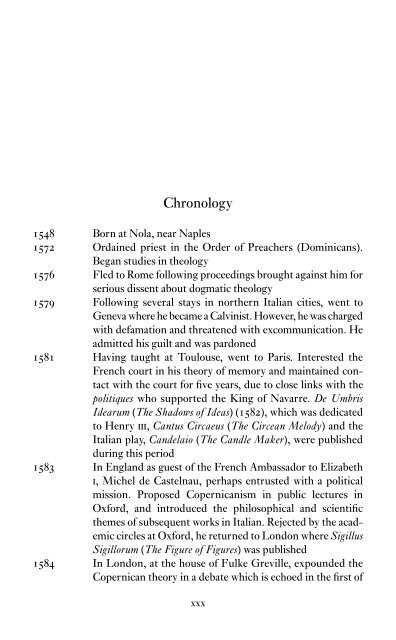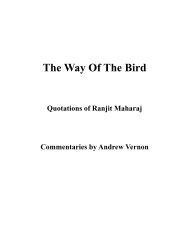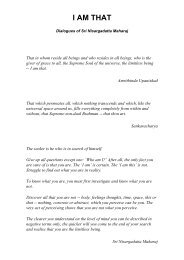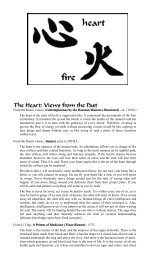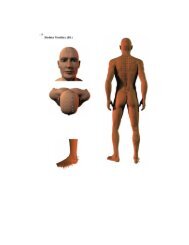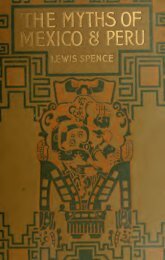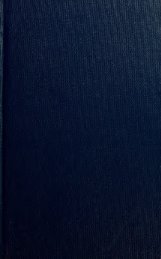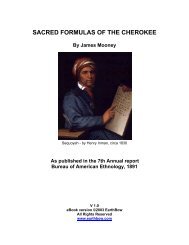- Page 2 and 3: This page intentionally left blank
- Page 4 and 5: CAMBRIDGE TEXTS IN THE HISTORY OF P
- Page 6 and 7: PUBLISHED BY THE PRESS SYNDICATE OF
- Page 9 and 10: Introduction Giordano Bruno was bor
- Page 11 and 12: Introduction existence of such a sp
- Page 13 and 14: Introduction metaphysics which is i
- Page 15 and 16: Introduction traditional cosmology.
- Page 17 and 18: Introduction it be contracted, as i
- Page 19 and 20: Introduction these are only appeara
- Page 21 and 22: Introduction substance, which Bruno
- Page 23 and 24: Introduction nature of his presence
- Page 25 and 26: Introduction All this throws light
- Page 27 and 28: Introduction (whose link with our i
- Page 29 and 30: Introduction servitude of their own
- Page 31: Introduction constituent moments, o
- Page 35 and 36: Chronology 21 December, he said he
- Page 37 and 38: Further reading Heroic Frenzies, tr
- Page 39: Cause, Principle and Unity
- Page 42 and 43: Cause, principle and unity gainsayi
- Page 44 and 45: Cause, principle and unity so that
- Page 46 and 47: Cause, principle and unity however,
- Page 48 and 49: Cause, principle and unity permanen
- Page 50 and 51: Cause, principle and unity and gloo
- Page 52 and 53: Cause, principle and unity when you
- Page 54 and 55: Cause, principle and unity you in w
- Page 56 and 57: Cause, principle and unity and subl
- Page 58 and 59: Cause, principle and unity FILOTEO.
- Page 60 and 61: Cause, principle and unity FILOTEO.
- Page 62 and 63: Cause, principle and unity instead
- Page 64 and 65: Cause, principle and unity most par
- Page 66 and 67: Cause, principle and unity the susp
- Page 68 and 69: Cause, principle and unity Calepino
- Page 70 and 71: Cause, principle and unity Silenes,
- Page 72 and 73: Cause, principle and unity TEOFILO.
- Page 74 and 75: Cause, principle and unity token of
- Page 76 and 77: Cause, principle and unity things w
- Page 78 and 79: Cause, principle and unity execute
- Page 80 and 81: Cause, principle and unity the form
- Page 82 and 83:
Cause, principle and unity TEOFILO.
- Page 84 and 85:
Cause, principle and unity POLIINNI
- Page 86 and 87:
Cause, principle and unity mixed, t
- Page 88 and 89:
Cause, principle and unity it every
- Page 90 and 91:
Cause, principle and unity POLIINNI
- Page 92 and 93:
Cause, principle and unity POLIINNI
- Page 94 and 95:
Cause, principle and unity to the t
- Page 96 and 97:
Cause, principle and unity nature,
- Page 98 and 99:
Cause, principle and unity horsenes
- Page 100 and 101:
Cause, principle and unity is const
- Page 102 and 103:
Cause, principle and unity them, no
- Page 104 and 105:
Cause, principle and unity before t
- Page 106 and 107:
Cause, principle and unity numerous
- Page 108 and 109:
Cause, principle and unity does not
- Page 110 and 111:
Cause, principle and unity Oh! I se
- Page 112 and 113:
Cause, principle and unity in her,
- Page 114 and 115:
Cause, principle and unity incorpor
- Page 116 and 117:
Cause, principle and unity of being
- Page 118 and 119:
Cause, principle and unity TEOFILO.
- Page 120 and 121:
Cause, principle and unity TEOFILO.
- Page 122 and 123:
Cause, principle and unity unfolds
- Page 124 and 125:
Cause, principle and unity the head
- Page 126 and 127:
Cause, principle and unity breadth
- Page 128 and 129:
Cause, principle and unity totally,
- Page 130 and 131:
Cause, principle and unity (althoug
- Page 132 and 133:
Cause, principle and unity Secondly
- Page 134 and 135:
Cause, principle and unity gather c
- Page 136 and 137:
Cause, principle and unity triangle
- Page 138 and 139:
Cause, principle and unity There wa
- Page 141:
On Magic
- Page 144 and 145:
On magic incensings, sacrifices, re
- Page 146 and 147:
On magic usually mentioned fields o
- Page 148 and 149:
On magic subject rather than anothe
- Page 150 and 151:
On magic While bronze is more simil
- Page 152 and 153:
On magic apprehends all things, how
- Page 154 and 155:
On magic parts of another body, but
- Page 156 and 157:
On magic This philosophy is supreme
- Page 158 and 159:
On magic How a magnet attracts iron
- Page 160 and 161:
On magic there are many large magne
- Page 162 and 163:
On magic It is easy for demons to p
- Page 164 and 165:
On magic This is what alteration, m
- Page 166 and 167:
On magic are expelled and replaced
- Page 168 and 169:
On magic Let us now turn our attent
- Page 170 and 171:
On magic On the bondings of spirits
- Page 172 and 173:
On magic is due sometimes to the la
- Page 174 and 175:
On magic Further, one should note t
- Page 176 and 177:
On magic disturbed by things which
- Page 178 and 179:
On magic readily to where the seed
- Page 180 and 181:
On magic Thus, someone who is less
- Page 183 and 184:
A general account of bonding Anyone
- Page 185 and 186:
A general account of bonding and fo
- Page 187 and 188:
A general account of bonding 12. No
- Page 189 and 190:
A general account of bonding the mo
- Page 191 and 192:
A general account of bonding person
- Page 193 and 194:
he does not move unless he is attra
- Page 195 and 196:
A general account of bonding 2. The
- Page 197 and 198:
A general account of bonding such a
- Page 199 and 200:
A general account of bonding in old
- Page 201 and 202:
A general account of bonding it tha
- Page 203 and 204:
A general account of bonding bound
- Page 205 and 206:
A general account of bonding adoles
- Page 207 and 208:
A general account of bonding to foo
- Page 209 and 210:
A general account of bonding Mercur
- Page 211 and 212:
A general account of bonding chaos
- Page 213 and 214:
A general account of bonding beauty
- Page 215 and 216:
Index accident and substance 6, 9,
- Page 217 and 218:
Index measurement 169 motion 158-9
- Page 219 and 220:
Index ubiquitous 49-50 see also div
- Page 221 and 222:
Index doctorates 26-7 natural viii-
- Page 223 and 224:
Index world-soul (anima mundi) xi-x


